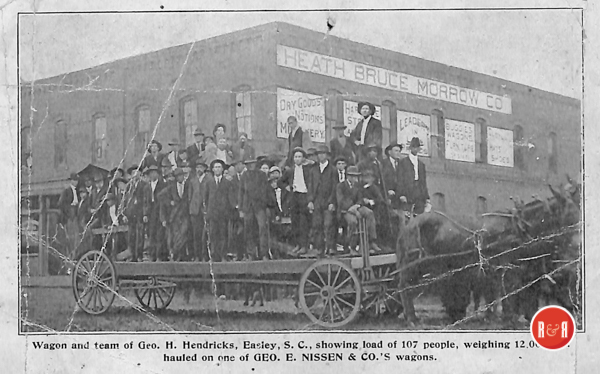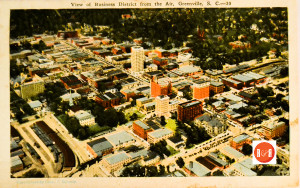
Early postcard view of Greenville showing their industry built around the falls. Courtesy of the Martin Collection – 2014
“Created in 1786, Greenville District was formed out of land that had been once been owned by the Cherokee Indians. It was originally one of the Ninety Six District. It sat between the Saluda River and the Indian Boundary line of 1767, the area had been divided between Spartanburg and Laurens until Greenville was founded. During the 1760’s there had been a few illegal settlers on the Cherokee lands and after the Revolutionary War parcels of land began to be surveyed and sold by the state. Coming from Spartanburg and Laurens Counties the first settlers were Scots-Irish and English. Veterans from the Revolution were the populous in getting state bounty lands. Over nine percent of the population by 1790 was black. The county soon had its own store, a Presbyterian, a Methodist, and two Baptist churches. The county was majority Presbyterian until after the Civil War. Unlike most of the backcountry, in 1788 the Greenville debates supported the federal constitution.

Loading a wagon in Easley, S.C., courtesy of the AFLLC Collection – 2017
Before the Civil War the economy of Greenville was agriculturally based on wheat and corn. There were a few mills and foundries at the time. In 1797 a wagon road across the mountains to Ashville and Knoxville opened and it brought trade and numerous taverns to the area. The village of Greenville was laid out in 1797 and became the mercantile center for the district. Following the War of 1812, a series of textile mills were built by Rhode Island textile entrepreneurs along local rivers. Vandy McBee, the largest landowner in the Greenville area, led efforts to have the Greenville to Columbia railroad built. The railroad was completed in 1853.

Image courtesy of the Miriam and Ira D. Wallach Division of Art, Prints and Photographs: Print Collection, The New York Public Library. The New York Public Library Digital Collections.
During the 1850’s Greenville became a busy commercial center. From 1825 to 1850 it grew almost three fold from 500 to 1,305. In 1851 Furman University was established in Greenville, the Greenville Female College was established in 1855 and in 1859 the Baptist Theological Seminary was established. By the end of the 1850’s the South’s largest carriage and wagon plant was in Greenville and it employed about eighty workers.
The Yorkville Enquirer reported on June 28, 1877 – “The Baptist Theological Seminary presently located at Greenville will be loved to Louisville Kentucky.”
Greenville was able to quickly recover from the Civil War and the Reconstruction. In 1872 Greenville received its second railroad and in 1874 and 1875 two cotton mills started productions. It was during this time that Greenville made a shift from being an agricultural trading town to an industrial center. There were eight mills in operation in the city in 1894 and by 1902 there were fourteen mills. The mills were bringing Greenville closer to city status as they brought in new businesses and laborers. Mill villages were established on the perimeter of Greenville to house and care its workers. Prosperity and stability were brought to Greenville by the mills and nice Victorian neighborhoods rose up around the downtown area. The Hampton-Pinckney neighborhood became the home to many prominent citizens in the 1890’s and 1900’s.

Early postcard view of farmers coming to town to trade in Greenville, S.C. Courtesy of the AFLLC Collection – 2017
Before the Civil War the Mansion House had been a favorite resort for the wealthy planters from the low country of South Carolina. During the late 1870’s money was spent to remodel, enlarge, and equip the building in a more modern style. This was done under the management of A.A. Gates a popular hostelry.
The Yorkville Enquirer reported on Feb. 20, 1873 – “The Manion House has been sold at auction for $26,000. to J.W. Gray.”
The Mansion House was located on Main Street and was three stories high. It had fine parlors, reception and reading rooms, and on the first floor it had it had barber shops, bathrooms, bar and billiard parlors. A well known Charlestonian, C.J. Holloway, ran the barber shop. The Mansion House had electricity and had a steam laundry. Other hotels in the city were the Exchange Hotel on Washington Street that was managed by Captain W.R. White, a native of Abbeville. It had 35 bedrooms, and was well carpeted and well furnished. The Goodwin House located on Main and Washington Street was run by Miss. Mary Latimer. The Central Hotel on Main Street was

Postcard image of the Woodside’s Building in downtown Greenville, S.C. Courtesy of the Revels Collection – 2015
run by A. M. Stephens. The Hotel Altamonte was opened in 1889 on top Paris Mountain. It had a complete water system, electric call bells, and a telephone connection to Greenville. Mr. A.H. French was the first manager of the hotel.
In 1889 Greenville was lit by forty six Brush electric arc lights. Each of these lights had 2,000 candle-power. The city owned plant supplied six hundred incandescent lights to individuals. At this time there was also another plant that operated the Thomson-Houston system that was controlled by Messers, Ashbury & Son. They furnished arc and incandescent lights to mills, hotels and merchants.
The Yorkville Enquirer reported June 26, 1873 – “The depot for the Airline Railroad has been completed in Spartanburg and the one in Greenville should be finished in the month. The entire line to Atlanta should be completed by August 1st.”
As the twentieth century arrived Greenville’s growth was noted nationwide. During the Spanish American War, five regiments of New England region National Guard troops were stationed near the city. During World War I, troops were again stationed near the city and the mills quickly turned out cloth for the war effort. Greenville’s Textile Hall for the Southern Textile Exposition was completed in 1917. This building was designed so the mills could exhibit textile machinery and products. It also had the other purpose as being a civic auditorium for the city. Greenville’s economy was boosted with the production of war materials through the 1910’s and it led to a building boom in the 1920’s.

View of progressive Greenville, S.C. ca. 1920. Courtesy of the Willis Postcard Collection – 2016
The residential areas grew as a direct result of the expansion of the mills and the inner city businesses. There were 435 mercantile establishments, 9 banks, 42 churches, 7 colleges, 2 daily newspapers, 15 miles of street railways, 5 railroads and 25,000 mill employees in Greenville in 1911. In 1910 the population of Greenville was 15,700 and ten years later it had risen to 23,700.
The Yorkville Enquirer reported on Feb. 14, 1894 – “The offices of the Greenville Daily News was partially destroyed by fire last Sunday. Nearly all the materials on the first floor were lost but many of the items in the editing and composition rooms on the second floor were saved.”
The number of mills had risen to twenty in 1920. A building boom hit Greenville during the 1920’s. There were approximately 110 residential structures built and 220 houses built in the suburbs in 1923. In 1925 the Poinsett Hotel, with its twelve stories, was completed in 1925. Also built in 1925, the ten story Chamber of Commerce of Building and South Carolina’s largest furniture store and a theater.
Due to the mills and expanding economic base, Greenville was the second richest city in South Carolina in 1920, but it was only third in population. By the mid twenties it claimed to be the textile center of the south.

Postcard image courtesy of the Revels Collection – 2015
The industry in Greenville has become more diversified since World War II, in 1955 there were 254 manufacturing plants. In the 1950’s Greenville was more urban it had 129 schools, 220 churches, three airlines, and four railroads. Many new businesses moved to the area to take advantage of the economic climate during the 1960’s and 1970’s. There was increased construction and many areas in the inner city were transformed by new housing and modern business.”
Information compiled and written by Anna Lee – 2014, with assistance from Edgar, Walter B., ed. The South Carolina encyclopedia. Columbia, SC: University of South Carolina Press, 2006 and the South Carolina Gazetteer by J.H. Moore, 1989.
Stay Connected
Explore history, houses, and stories across S.C. Your membership provides you with updates on regional topics, information on historic research, preservation, and monthly feature articles. But remember R&R wants to hear from you and assist in preserving your own family genealogy and memorabilia.
Visit the Southern Queries – Forum to receive assistance in answering questions, discuss genealogy, and enjoy exploring preservation topics with other members. Also listed are several history and genealogical researchers for hire.
User comments welcome — post at the bottom of this page.


Share Your Comments & Feedback: